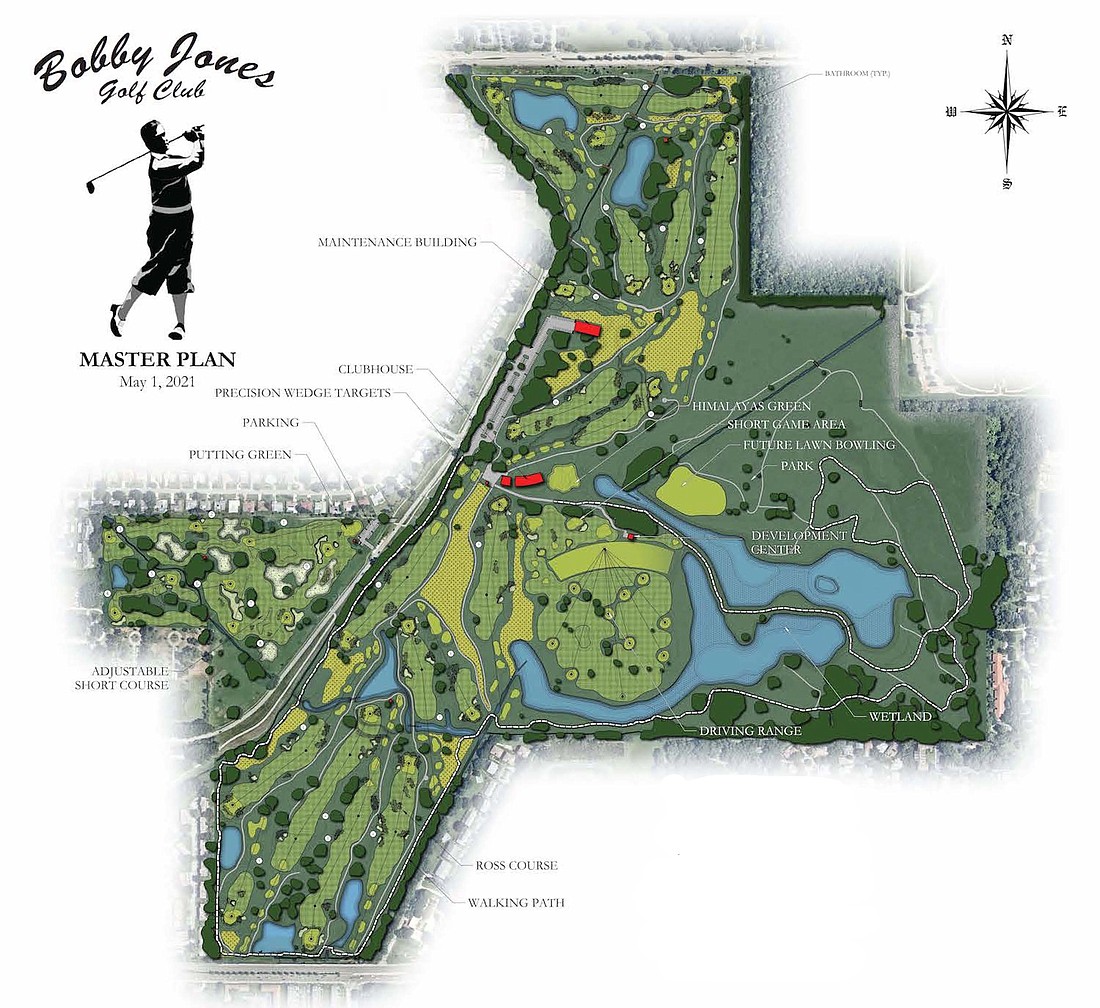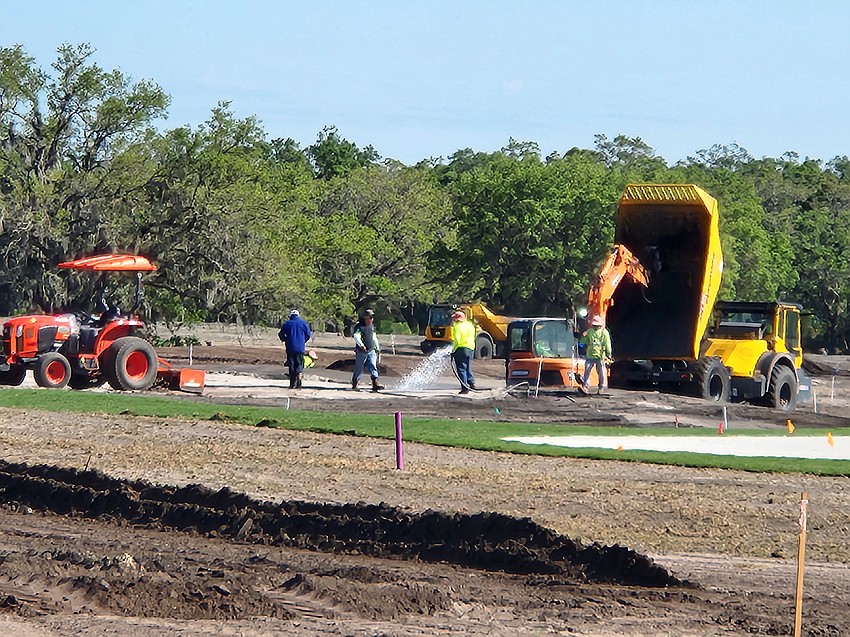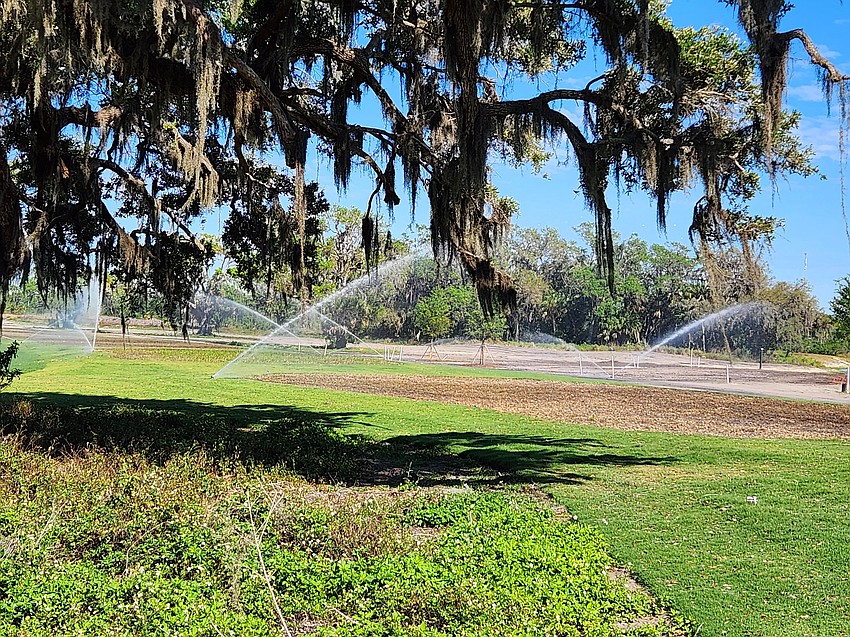- December 22, 2024
-
-
Loading

Loading
 Courtesy
Courtesy
With sod installed around the greens, tee boxes visible from Fruitville Road and fairways sprigged on some of the back-nine holes along 17th Street, the Bobby Jones Golf Course is starting to look like a golf course again.
Now that fine-tuning is underway on the front nine in preparation for sprigging the tees, rest of the fairways, rough and all 18 greens in his restoration of the original 18 holes designed by famed golf course architect Donald Ross, architect Richard Mandell is turning his focus on the nine-hole “adjustable” par-3 course across Circus Boulevard from the golf club’s main entrance at Azinger Way.
Mandell, a Pinehurst, North Carolina-based course architect who specializes in Donald Ross restorations, is enthusiastic about the pitch-and-putt companion course. Heavy equipment is currently shaping the layout on the 25-acre city-owned property across Circus Boulevard from the primary facility.
The main course is Ross, with modifications for modern water management techniques that didn’t exist when it was built nearly 100 years ago. The short course, though, is all Mandell.
“The short course is 100% mine to do what I want with it,” Mandell said. “It strays from the original plans a bit here and there, and I’m working to formulate what its personality is going to be. The original plan had native waste areas and I wasn't really sure how that would shake out until we got into it.”
The short course is described as adjustable because it is intended to offer flexibility in routing. Playing at 1,009 yards, the score card shows the longest hole at 173 yards and the shortest at 78, offering a variety of short-game shot selections. Among the changes from his original vision, Mandell has eliminated traditional bunkers. Instead, the course will be composed largely of native sand areas and grass, resembling a links-style course.
Unlike the Ross course, which was built atop an urban watershed, the short course site has a sandy foundation that offers effective natural drainage off the site. Mandell speaks about it like a kid in a pro shop.
“This is the first course I’ve been able to design from scratch that is pure sand, so it puts me in another realm where I can do different things,” Mandell said. “If you're building a golf course, you want to build it on pure sand. All of your links courses are on sand, and so you can do more things because it naturally drains.”
There will be retention basins on the course, but otherwise golfers can expect more of a links golf experience on the short course — few if any forced carries with an emphasis on a strong ground game — which Mandell said will appeal to the spectrum of golf skills.
“I think this course is going to be a major attraction for all golfers, but I’ve got to make sure that it's playable for seniors and juniors,” Mandell said. “It will be a great golf course for a low handicapper to have a lot of fun and still make it playable for junior golfers and senior golfers as well.”

The main attraction, though, will be the Ross course, designed in 1925 and named Municipal Golf Course and Recreation Grounds when it opened in 1926. It was dedicated in 1927 when Jones. The legendary golfer was already well known in the community as a sales executive for a real estate developer.
It is Mandell’s 12th Ross course restoration, which follows the original 18-hole design with necessary updates to facilitate drainage. Built on a floodplain, soil was removed from the 120 acres of what are now wetlands to elevate the golf course. The routing is the same and the greens follow the original Ross specs, but regular Bobby Jones golfers will likely notice some changes.
Among the differences from the original layout is the length, playing 6,715 yards from the back tees compared to the original Ross course at 6,230 yards. With a set of “Ross” tees, golfers may play the original length.
The greens follow the original Ross specs — Mandell found them in the Tufts Archives in Pinehurst — but regulars who played the original layout as part of an expansion that created a 36-hole complex will note some changes between the tees and greens.
“We raised all the playing areas above the 100-year floodplain,” Mandell said. “We have water features that were not part of the original Ross plan, but we had to have them to make sure the course drains properly. We're not going to spend all this money and have it wet like it was before.”

The golf course restoration and wetlands creation was budgeted at $12.5 million, the entire project funded by a $20 million city bond and a $3 million in grant from the Southwest Florida Water Management District. Included in that total are accessory buildings such as two on-course restroom structures, a driving range building, the Gillespie Building at the short course and temporary clubhouse.
Final plans for the permanent clubhouse are still being developed. Currently, there is no time frame set for its construction.
“We have a couple of designs in hand and the plan is to present them to the City Commission, most likely sometime in April, and staff will be asking for direction on which design they want to pursue,” said John Kretzer, the city’s project manager.
Closed in 2020, prior to excavation the only reminder that remained of the golf course along Fruitville Road was a deteriorating sign as nature reclaimed the property. That sign is gone, and now visible from there are parts of holes 3 through 6.
“It is absolutely daunting, seeing the changes that have taken place there,” Kretzer said. “It’s nice to see Donald Ross' vision take shape in front of us.”
Sprigging on the front nine will begin within a few weeks, according to Kretzer. The contractor is awaiting the arrival of the sprigs from a farm in Georgia, where the weather is not quite warm enough for growing and cutting sprigs.
Construction moved from the back nine forward to follow the flow of water, both above and below the surface.

“When you drive down 17th Street you can see that there's a large water tank, which is the source of the irrigation for the golf course,” Kretzer said. “All of the infrastructure for the golf course originates from that point. It just made sense to start there and work forward. A lot of excavated soil was needed to build up the front side to a higher elevation to help alleviate some of the flooding problems that we used to have there.”
That flooding primarily came from overflows of Phillippi Creek Main B, flows from University Parkway through The Meadows, then beneath 17th Street, across a portion of the back nine and then along Circus Boulevard. That follows the drainage of the entire property from 17th Street to Fruitville Road.
Raising the golf course to create new wetlands serves the dual purpose of mitigating the flooding while naturally filtering the water flowing southward through the site.
“We’ve designed a system that will bring water onto the site during heavy rains,” Mandell said. “From there it will slowly flow through the wetlands where it will be naturally filtered, then it will be slowly released, which protects everybody downstream.”